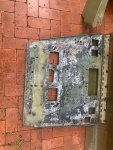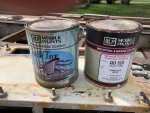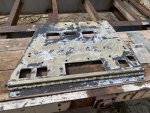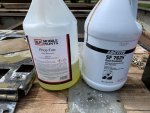- 232
- 126
- 43
- Location
- Abilene, Texas
I saw this discussion pop-up again in my inbox this week. Anyway, this reminds me of everyone's opinion of how to get rid of prickly pear cactus out here in west Texas. You hear a bunch of wise tales and untruths about how you get the job done. It's easy, rake and pile it. It's like raking underbrush. There are different ways of piling and raking to be efficient at it. It all depends of the coverage and how much you have per acre. Anyway, Cactus does not like to be piled. It rots very fast and turns to mulch. Okay, so how does this apply to the art of prepping a new surface? Well, it all depends on how good you want the result to be... The answer to the method is pretty simple. Blast and scale clean! Use the HF blasting cabinet for small parts & bolts. Cut out bad metal and mig weld new structure in its place. Forget bondo gel or other fillers for metal rot. Let your scaled and sand blasted surfaces rust naturally with some good old nitrogen rich rain. A week or so before painting, soak spray the parts and body parts down with OSPHO which will oxidize the natural rust. Use Loctite "Extend" on certain things but not every thing. Extend has "body" to the liquid, and dries like a plastic coating. Too expensive for large areas or things. OSPHO or GEM is putting on muratic acid. It's thin, and it prepares the metal for priming. They say you can use it as a primer, but I put down primer over it.
Blasting does not always work, especially on thick paint. You must scale!!!! Forget the paint removers. Those are a mess and more expensive to use than any other method. I have never seen panels warp from sand blasting. If you try to drill a hole then it will probably warp after a full tank of sand. You must scale the hard stuff. Have your bench grinder near by to keep a flat cutting edge on the end of those needles. When the edge rounds off it is time to resurface. I have never ruined anything with the needle scalier. I'm not going to use a needle scalier on something that I'm worried about being perfect. The scaling dings "if any" are a better bonding surface for primer to begin with. More on paint next....
Blasting does not always work, especially on thick paint. You must scale!!!! Forget the paint removers. Those are a mess and more expensive to use than any other method. I have never seen panels warp from sand blasting. If you try to drill a hole then it will probably warp after a full tank of sand. You must scale the hard stuff. Have your bench grinder near by to keep a flat cutting edge on the end of those needles. When the edge rounds off it is time to resurface. I have never ruined anything with the needle scalier. I'm not going to use a needle scalier on something that I'm worried about being perfect. The scaling dings "if any" are a better bonding surface for primer to begin with. More on paint next....





